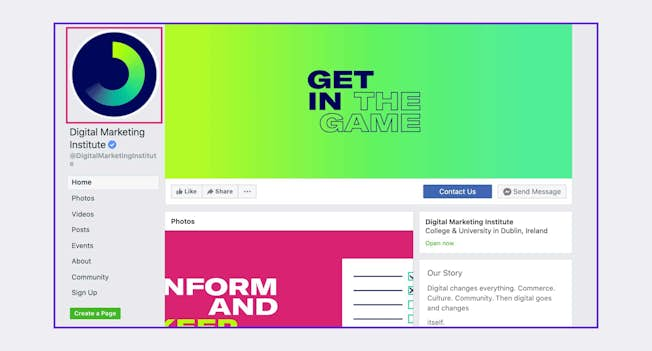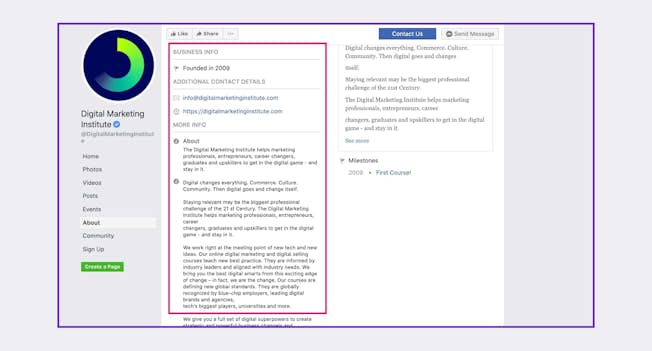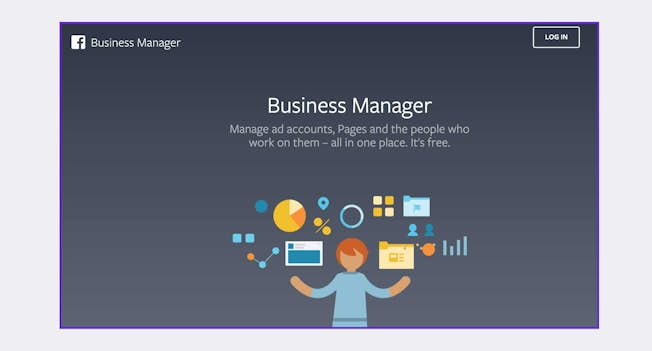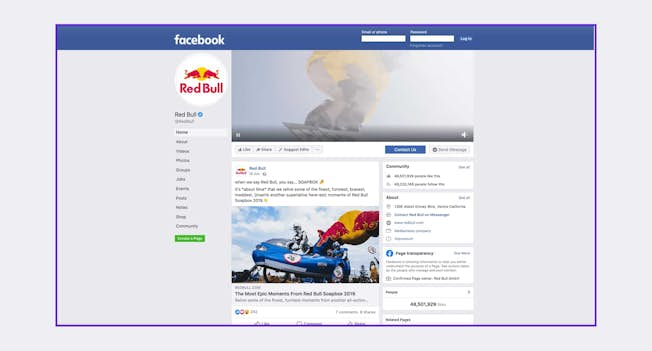If you have a business, then it’s a good idea to create a Facebook business page. You can use it to let people know about your business, products, and services. And it can help you reach millions of potential customers, as well as their ‘friends’. Read our handy guide and find out more about Facebook business pages, and how you can create one for yourself.
Creating a company profile
When setting up a social media experience for your business on Facebook – or on any other social channel – you’ll begin by creating a company profile. To complete your company profile, you’ll need to create and upload assets, including profile pictures and cover photos.

Use engaging images
Making a strong first impression is vital on social media, as users are moving between profiles and feeds very quickly. So always choose images that depict your brand in a positive or engaging way. For example, use a brand logo as your business profile picture or an engaging image that depicts your brand - this might include your products or people. This image can be updated regularly to fit with your marketing calendar. For example, you might add snow to your logo at Christmas time, or love hearts on Valentine’s Day, and so on.
When it comes to the cover photo, ensure there is a focal point in the photo. You can include light calls-to-action like phone numbers or current special offers, but don’t forget to update them regularly.
Include a company bio
To complete your company profile, you’ll also need to add a short bio to introduce your business and what you do. Make sure that the tone of the bio is appropriate to your audience and consistent with your brand’s own tone of voice. Some social channels also allow you to include a ‘contact details’ section and links to your website.

Talk to your target customer
The most important part of setting up a social media business profile is to think about who you are talking to, how they like to be communicated with, and how you can engage them with your brand message and meaningful content. So do take the time to fill in all of the sections with your target customer in mind.
Be consistent
It’s also vital to keep the information you post as consistent as possible across all the sites. Ensure that the images, videos, and text that you use are consistent with your brand. You may have conversations with the same people on multiple platforms, so you’ll want to position your brand in a way that’s easy for them to recognize and engage with.
Steps for setting up a business page on Facebook
Now let’s look at how you can set up a business page on Facebook. Well, there are two ways to do this:
1. Create a standalone page
The first way is to create a standalone page from your existing personalFacebook profile. However, this is quite basic and has limited functionality.
2. Create a Business Manager account
The second wayis to create a free Business Manager account, and create or import client pages to that account. Facebook Business Manager allows you to post content and create ad campaigns, and is the most efficient way to manage your Facebook presence for business.
To create a Business Manager account, follow these steps:
- Login to Facebook or create a new profile
- Visit https://business.facebook.com/ and choose Create an Account
- Enter Your Details
- Go to Business Settings
- Click the Pages tab
- Click Accounts and click Pages
- On the right-hand side of the Page, click Add New Pages
- Select Create a New Page
- Enter the page name and other details, and upload creative assets when prompted to do so
Tip: It is also possible to Add an Existing Page which you own, or Request Access to a Page from a client.

Benefits of using Facebook Business Manager
It is recommended that digital marketing professionals choose to run and manage social activity through Facebook Business Manager, as it allows for more precise targeting options, centralized management of all pages and ad campaigns, integration with Instagram, and other enhanced features that aren't as readily available through native page creation. Overall, you can do more, and do it faster, with Business Manager, and this will give you an edge over competitors who opt for the native platform.
Best practices when posting on Facebook
When you’ve created your business page, you can get busy posting! When posting content on social platforms like Facebook, there are some tried-and-tested best practices that you should follow. Here are three golden rules:
- First of all, your post should be succinct. Attention spans for humans are shorter than ever, so you need to make your point quickly.
- Secondly, you want to make sure that your post is super topical and relevant to your audience.
- Thirdly, make sure that your posts are providing value. In addition to your posts being relevant and topical, you want to make sure that they include an explicit CTA or a link, so that your audience knows exactly what you want them to do with this information – for example asking them to comment, like, or share.
Types of Facebook page post
Let's talk about page posts. Facebook page posts are great ways to generate engagement with your fans and target audiences. Through page posts, you can share company news, product announcements, tips, contests, events, stories, and more.
There are a variety of different page posts available to marketers on Facebook. Let's go through each one:
- Link posts are simply posts that link out to a website off of the Facebook platform.
- Offer posts are for when you want to increase sales in your shops or online, offer a discount, or have a promotion. They are a great way to get people's attention and encourage them to act.
- Event posts are a feature that lets you organize gatherings, respond to invites, and keep up with what your friends are doing. As a business, you can create events to highlight in-store or online activities that you are planning. Once users agree that they are ‘interested’ or ‘going’, they will be notified when you post updates on your event page.
- Canvases are full screen, mobile-optimized, post-click experiences that can feature a combination of images, video, text, and links. You can create a Canvas with the Publishing Tools section of your page and your page composer. When you're done, you get a unique URL that you can use in website click and website conversion ads, mobile app ads, and photo or video page posts. People who tap an ad or post with a canvas on their mobile phones or tablets can interact with the canvas through text, pans, and swipes without leaving Facebook.
- Video posts include a native video uploaded directly to Facebook, rather than posting a link to a video from a third-party site. A video link offsite would be considered a link post.
- Slideshow posts can be created for Facebook (and Instagram) on your mobile phone or using a desktop computer. Slideshow videos will play on smartphones, tablets, and computers, just like a video. Using slideshow ads, you can create a customized, high-quality video without the hassle or expense of video production. Combine multiple images, text, and sound in your slideshow to capture the audience's attention and tell a story with photos.
- Photo posts can be shared with or without text, and of course, include an image.
- And lastly, text posts are exactly that – posts with only text.

Setting up a Facebook campaign using Business Manager
After you’ve created a Facebook business page, you can take the next step and create a paid promotion campaign on the platform. Follow these steps to create a paid Facebook campaign using Business Manager:
- Log in to Facebook Business Manager
- Navigate to Business Settings and then to Create or Import an Ad Account
- In your Ad Account, choose Create New Ad
- Set your Objective and Name Your Campaign
- Define Your Audience, Network – Facebook, Instagram, or both – and Device in your Ad Set
- Set your Budgets and Run dates
- Select Your Creative Formats
- Push your campaign Live
Keep the following in mind as you create your campaign:
Objectives
It’s important to choose the KPIs and objectives you’d like Ads Manager to optimize your Facebook campaigns towards:
- Awareness KPIs include brand awareness and reach.
- Consideration KPIs include traffic, engagement, app installs, video views, lead generation, and messages.
- Conversion KPIs include conversions, catalog sales, and store visits.
Note: Facebook and Instagram are usually more effective in the awareness and consideration stages of the buyer’s journey.
Targeting
Audience targeting helps you show your ads to the people that are most relevant to your message based on location, demographics, and their behavior off of Facebook. By selecting the right targeting options, you can implement a strategy that focuses on reach and precision at scale while eliminating waste.
People factors include:
- Basic demographics, such as age, gender, and location
- Interests, such as business, family, hobbies, entertainment, shopping, and technology
- Behaviors, such as purchase patterns, travel, and mobile usage
- Detailed demographics, such as relationship status, education, and job titles
- Connections, such as people who like or don't like your page or events, or who installed your app
- Custom audiences, such as those created from remarketing lists
Ad location factors include:
- Network placements, such as Instagram, Facebook, Messenger, and Facebook Partner Websites
- Devices, such as mobile or desktop
- Mobile type, such as IOS or Android
Budgets, bids, and run dates
There are a number of budgeting and ad serving options available on Facebook.
First, let’s look at budgets. You can set daily budgets and optional campaign spend limits for ongoing ‘always-on’ activities with no end date. You can also set lifetime budgets for campaigns that have a specific end date, so you only spend up to that budget limit.
Next, let’s turn to bidding. You can control your bidding options on Facebook. It is recommended that you set your bids to Automatic Optimized Cost per Thousand Impressions, or CPM. However, you could set your bids to Manual CPC or to Target Cost, for app installs or leads.
When it comes to your ad schedule, you can set ads to only serve at certain times with lifetime budgets. Depending on the campaign objective, you can also allow Ads Manager to optimize your different ad formats, to drive specific actions for that objective. For example:
- Landing Page Views show your ad to the people who are most likely to click through to your website's landing page.
- Impressions show your ad as often as possible.
- Daily Unique Reach show your ad once per day to your audience.
Creative formats
There are a number of creative formats available to use on Facebook. These include:
- Single Image
- Single Video
- Slideshow
- Offers
- Events, and more
Experiment with the different creative formats, and test to see how they engage your audience and how they deliver on your objectives
Final Word
That’s it! Now you have the basic tools you need to set up a Facebook business page and to advertise on the platform. So don’t get left behind. Start making the most of Facebook and its powerful features today, and let the world know about your brand or business. You’ll be glad you did.
Related
- Categories:
- Articles
- Social Media Marketing
Upgrade to Power Membership to continue
your access to thousands of articles, toolkits, podcasts, lessons and much much more.
Become a Power Member- Login
- View Courses
- - - -
- Courses
- Resources
- - - -
- My Account
- Change Password
- Logout




